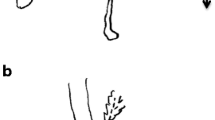The early stages of colonization by Tetraponera (= Pachysima) aethiops (Pseudomyrmecinae) to its obligate host plant, Barteria fistulosa (Passifloraceae), was studied in Kahuzi-Biega National Park, Democratic Republic of Congo (formerly Zaire). In our observations, as many as 36 queens colonized a seedling, and all of the established colonies had just a single queen each. The ants depend totally on the products of scale insects which inhabit the domatia. The ants damage the terminal meristems of the branches where other incipient colonies may inhabit. This tip-biting behavior may deteriorate the nutritional condition of scale insects and suppress the growth of the competing colonies. Ants pruned the plants near the edge of the trunk of the host tree most intensively, even the foliage of the lowest branch in shade. This observation supports the hypothesis that the main driving force which leads to pruning behavior is intercolony competition rather than improving the light condition of the host tree.
Similar content being viewed by others
REFERENCES
Bequaert J. (1922). Ants in their diverse relations to the plant world. Bulletin of the American Museum of Natural History 45: 333–584.
Davidson D. W. & Fisher B. L. (1991) Symbiosis of ants with Cecropia as a function of light regime. In: Ant–Plant Interactions (eds C. R. Huxley & D. F. Cutler) pp. 289–309. Oxford University Press, Oxford.
Davidson D. W., Longino J. T., Snelling R. R. (1988) Pruning of host plant neighbors by ants: An experimental approach. Ecology 69: 801–808.
Hölldobler B. & Wilson E. O. (1990) The Ants. The Belknap Press of Harvard University Press, Cambridge.
Janzen D. H. (1966) Coevolution of mutualism between ants and acacias in Central America. Evolution 20: 249–275.
Janzen D. H. (1967) Interaction of the bull’s-horn acacia (Acacia cornigera L.) with an ant inhabitant (Pseudomyrmex ferrugineus F. Smith) in eastern Mexico. Kansas University Science Bulletin 47: 315–558.
Janzen D. H. (1969) Allelopathy by myrmecophytes: The ant Azteca as an allelopathic agent of Cecropia. Ecology 50: 147–153.
Janzen D. H. (1972) Protection of Barteria (Passifloraceae) by Pachysima ants (Pseudomyrmecinae) in a Nigerian rain forest. Ecology 53: 885–892.
Longino J. T. (1989) Geographic variation and community structure in an ant–plant mutualism: Azteca and Cecropia in Costa Rica. Biotropica 21: 126–132.
Longino J. T. (1991) Azteca ants in Cecropia trees: Taxonomy, colony structure, and behavior. In: Ant–Plant Interactions (eds C. R. Huxley & D. F. Cutler) pp. 271–288. Oxford University Press, Oxford.
McKey D. (1984) Interaction of the ant-plant Leonardoxa africana (Caesalpineaceae) with its obligate inhabitants in a rainforest in Cameroon. Biotropica 16: 81–99.
Risch J. J., Mc Clure M., Vandermeer J., Walts S. (1977) Mutualism between three species of tropical Piper (Piperaceae) and their ant inhabitants. American Midland Naturalist 98: 433–444.
Yamagiwa J., Yumoto T., Maruhashi T., Mwanza N. (1993) Field methodology for analyzing diets of eastern lowland gorillas in Kahuzi-Biega National Park, Zaire. Tropics 2: 209–218.
Young T. R., Stubblefield C. H., Isbell L. A. (1997) Ants on swollen-thorn acacias: Species coexistence in a simple system. Oecologia 109: 98–107.
Yu D. W. & Davidson D. W. (1997) Experimental studies of species-specificity on Cecropia–ant relationship. Ecological Monographs 67: 273–294.
Yu D. W. & Pierce N. E. (1998) A castration parasite of an ant–plant mutualism. Proceedings of the Royal Society of London B 265: 375–382.
Yumoto T., Yamagiwa J., Mwanza N., Maruhashi T. (1994) List of plant species identified in Kahuzi-Biega National Park, Zaire. Tropics 3: 295–308.
Author information
Authors and Affiliations
Corresponding author
About this article
Cite this article
Yumoto, T., Maruhashi, T. Pruning behavior and intercolony competition of Tetraponera (Pachysima) aethiops (Pseudomyrmecinae, Hymenoptera) in Barteria fistulosa in a tropical forest, Democratic Republic of Congo. Ecol Res 14, 393–404 (1999). https://doi.org/10.1046/j.1440-1703.1999.00307.x
Received:
Accepted:
Issue Date:
DOI: https://doi.org/10.1046/j.1440-1703.1999.00307.x




